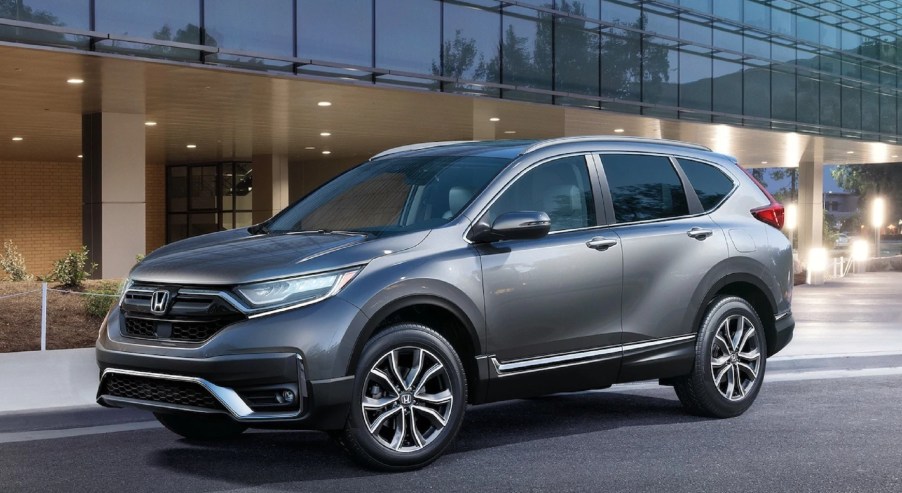
These Honda SUVs Really Do Match Their EPA Fuel-Efficiency Claims
Even though they’re crossovers, not body-on-frame SUVs, Honda’s ‘SUV’ lineup includes some fairly fuel-efficient models. At least, that’s what their EPA ratings claim. But vehicles don’t always meet those claims in the real world. However, sometimes they can match or even exceed them. And some of those vehicles are Honda SUVs.
Why is it hard to match EPA mpg claims in the real world?
Barring heavy-duty trucks, every vehicle comes with an EPA mpg rating for city and highway driving. These figures are displayed on the window sticker and have been since the 1970s, Car and Driver reports. However, while these fuel-economy ratings are published by the EPA, they don’t always come from the agency itself.
The truth is that the EPA doesn’t test every new vehicle on the market, Edmunds reports. It really only has the resources to test about 15% of the models sold in a given year, Car and Driver reports. Instead, it creates standardized testing procedures run on dynamometers that simulate city and highway driving behaviors. The automakers run these tests, report the results, and the EPA publishes the resulting mpg ratings.
Naturally, this has the potential for causing headaches. Firstly, because the automakers are essentially self-reporting, they can and have exploited loopholes in the test procedure. Case in point, Volkswagen’s Dieselgate.
Secondly, although the EPA’s mpg testing procedures have evolved over the years, they’re still simulations. They approximate the real world, but they’re rarely a perfect match, Autotrader explains. That’s why there’s a “your mileage may vary” disclaimer on stickers and in vehicle ads.
The disclaimer also applies to the Honda SUVs listed below. How you drive is different from how I drive and how another publication’s test-driver drives. As such, you might exceed the EPA mpg ratings, or see significantly lower real-world fuel-efficiency. But if you want to match the EPA claims, which can be found on FuelEconomy.gov, these are the Honda SUVs you should consider.
The 2021 Honda CR-V
The Honda CR-V lineup gained a hybrid model for the 2020 model year. However, it’s not necessarily the one to get if matching EPA claims is your goal.

For 2021, the Honda CR-V has a 1.5-liter turbocharged four-cylinder engine rated at 190 hp and 179 lb-ft. It comes standard with front-wheel drive, but AWD is optional. The EPA rates the FWD 2020 CR-V at 28 mpg city and 34 mpg highway. Getting it with AWD lowers that to 27 mpg city and 32 mpg highway. And in Car and Driver’s highway testing with an AWD Honda CR-V, testers matched the EPA rating.
Meanwhile, the hybrid version of Honda’s mid-size SUV has a 2.0-liter four-cylinder with two electric motors and a 1.4-kWh lithium-ion battery pack. Combined, the system makes 212 hp and 232 lb-ft. It’s also Honda’s first hybrid to come standard with AWD, Car and Driver reports.
Unfortunately, it couldn’t quite match its fuel economy ratings in Car and Driver’s hands. The EPA rates the 2020 CR-V Hybrid at 40 mpg city and 35 mpg highway. But in Car and Driver’s testing, the hybrid Honda SUV saw just 33 mpg in combined driving. However, when Autoblog tested it, the CR-V Hybrid got 35.4 mpg in mostly-highway driving.
The 2021 Honda Pilot 3-row SUV

The Honda Pilot doesn’t get a new engine for 2021. Honda’s sole 3-row SUV has a 3.5-liter V6 rated at 280 hp and 262 lb-ft, NADAGuides reports. And, like the CR-V, it’s available in FWD and AWD trims. However, the 2021 Pilot’s powertrain has one major upgrade: the 9-speed automatic transmission is now standard on every trim.
As a result, the 2021 Honda Pilot has slightly better fuel economy ratings than the 2020 model. In FWD trim, the EPA claims the 3-row Honda SUV gets 20 mpg city and 27 mpg highway. With AWD, that drops to 19 mpg city and 26 mpg highway. But in Car and Driver’s hands, the AWD 2021 Pilot actually exceeded its highway rating, seeing 27 mpg.
The 2021 Honda Passport
Finally, there’s the 2021 Honda Passport, which shares “a vast majority of its parts” with the Pilot, Autotrader reports. The biggest difference is the Passport doesn’t offer 3rd-row seating.

But in terms of their powertrains, the two Honda SUVs are identical. The 2021 Pilot has the same 3.5-liter V6 and 9-speed automatic as the Passport. And, like the 3-row crossover, it’s available with FWD or AWD.
The EPA rates the former at 20 mpg city and 25 mpg highway, with AWD lowering each figure by 1 mpg. Car and Driver managed to beat the EPA’s highway estimate by 3 mpg, seeing 27 mpg with an AWD Passport. And Roadshow saw 22 mpg in combined driving over its year-long test.
Follow more updates from MotorBiscuit on our Facebook page.


